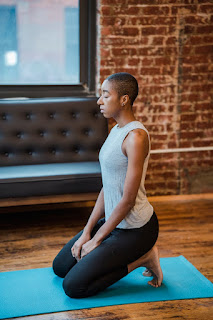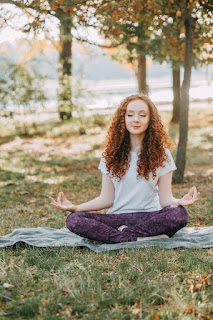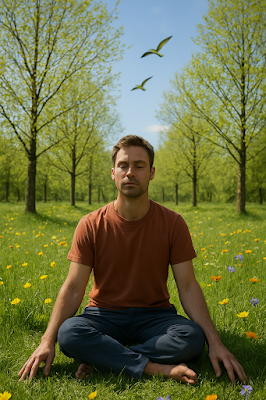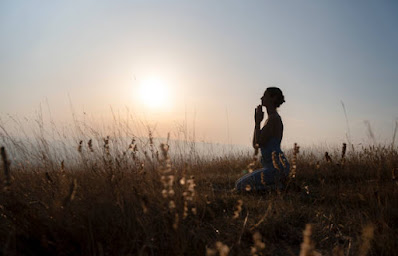Yoga at Home: Creating a Personal Sanctuary for Mind, Body, and Soul
In the hustle and bustle of modern life, finding a moment of peace can seem like a distant dream. Yet, imagine a sanctuary within your home—a tranquil space dedicated solely to the practice of yoga, where the stresses of the outside world melt away as you step onto your mat. “Yoga at Home: Creating a Personal Sanctuary for Mind, Body, and Soul” is not just an idea; it’s a journey towards cultivating a personal haven for yoga that promises profound transformations in your life.
Practicing yoga at home offers a unique opportunity to deepen your practice on your terms, allowing you to connect with your inner self without the distractions often found in external environments. It’s about creating a sacred space where you can explore the depths of your yoga practice, focusing on personal growth, self-discovery, and the pursuit of inner peace. This guide is designed to walk you through the essentials of setting up your home studio, building a consistent practice, leveraging online resources, staying motivated, and embracing the benefits of solo practice.
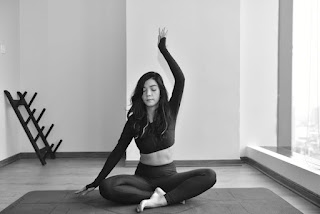
Embarking on this journey requires more than just rolling out a mat in a spare corner; it involves intentionally designing a space that reflects your personal needs, values, and the essence of yoga. Whether you’re a seasoned yogi or new to the practice, the following sections will equip you with everything you need to create a personal sanctuary that nurtures your mind, body, and soul.
Designing Your Yoga Space: Essentials for a Home Studio
Creating a dedicated yoga space at home is about more than just finding room for a mat. It’s about crafting an environment that inspires tranquility, focus, and a deep connection to your practice. Here’s how to create a space that resonates with the essence of yoga, making every session more meaningful.
1. Choose Your Space Wisely
Your yoga sanctuary should be a place where you can find peace and privacy. It doesn’t need to be large; even a small corner can be transformed into a serene retreat. Look for an area with minimal distractions, where you can comfortably move and stretch. Natural light and a view of the outdoors can enhance the ambiance, creating a more uplifting environment.
2. Keep It Minimal
Simplicity is key in yoga practice. Your space should be clutter-free to promote a sense of calm and allow energy to flow freely. Consider minimalist décor that includes only the essentials, ensuring every element serves a purpose or brings joy.
3. Incorporate Natural Elements
Incorporating elements like plants, stones, or water features can help connect you with nature and enhance the calming atmosphere of your space. Natural materials such as wood, bamboo, or cotton in your accessories and decorations can also help create a more grounded and serene setting.
4. Set the Mood with Lighting and Color
Soft, adjustable lighting can help set the right mood for your practice. Warm, dimmable lights or candles can create a soothing environment, while colors play a significant role in influencing your mood. Choose calming, earthy tones or soft pastels to promote relaxation and concentration.
5. Personalize Your Space
This is your personal retreat, so make it uniquely yours. Decorate with items that inspire you, such as motivational quotes, yoga-inspired art, or personal mementos that evoke a sense of peace and happiness. Your space should reflect your personal journey with yoga, supporting your practice both physically and spiritually.
6. Essential Equipment
Beyond your yoga mat, consider what other equipment you might need. Props like blocks, straps, and a bolster can enhance your practice, making poses more accessible and comfortable. A small speaker for music or guided sessions, along with a blanket for relaxation, can also be valuable additions to your home studio.
7. Maintain a Clean and Fresh Space
Finally, keep your space clean and fresh. Regularly airing out the room, keeping your equipment tidy, and perhaps incorporating an air-purifying plant or essential oil diffuser can help maintain an inviting and refreshing atmosphere, ideal for yoga practice
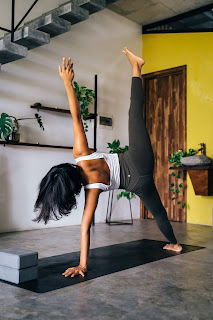
Building a Home Yoga Practice: Advantages and Tips
Embracing yoga at home invites a multitude of benefits into your life, from the flexibility of practice times to the intimacy of personal exploration. Here’s how to harness the full potential of your home yoga journey, ensuring it becomes a cornerstone of your daily routine and a profound source of personal growth.
The Freedom to Customize
One of the most significant advantages of practicing yoga at home is the ability to tailor your sessions to your specific needs, moods, and goals. Whether it’s focusing on meditation and breathwork or intensifying your physical practice, your home studio is a judgment-free zone where your yoga can evolve in alignment with your personal journey.
Developing Self-Discipline
Without the external structure of a class, you cultivate the invaluable skill of self-discipline. Setting a regular schedule for your practice helps instill a sense of routine, reinforcing your commitment to personal well-being and mindfulness.
Tips for Consistency
- Set a Regular Time: Choose a time of day when you’re least likely to be interrupted and stick to it, making yoga a non-negotiable part of your daily routine.
- Create Rituals: Begin each session with a small ritual, like lighting a candle or setting an intention, to signal to your body and mind that it’s time for yoga.
- Track Your Progress: Keep a journal of your practice, noting the poses you’ve mastered, the lengths of your sessions, and how you felt before and after. This can be a powerful motivator and a way to witness your own growth.
Embrace the Online Yoga Community
While practicing at home, you’re not alone. The online yoga community is vast and supportive, offering live-streamed classes, tutorials, and forums where you can share experiences, challenges, and achievements. Engaging with this community can provide a sense of belonging and motivation.
Personalize Your Practice
Your home yoga practice is a reflection of your inner self. Feel free to experiment with different styles, sequences, and durations. Use your practice as a tool for exploration, allowing it to be fluid and adaptable as you navigate through life’s ups and downs.
Creating a Supportive Environment
Remember, the space you practice in plays a crucial role in your journey. Ensure your home studio continues to evolve with you, adapting as your practice deepens. This might mean adding new props, changing the decor, or simply rearranging the space to keep the energy fresh and inspiring.
Patience and Kindness
Above all, be patient and kind with yourself. Some days, your practice may feel effortless; on others, it might be challenging to simply step onto the mat. Recognize that each day is different and that showing up for yourself, in whatever capacity, is a profound act of self-care.
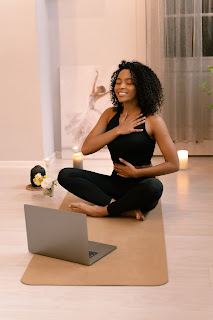
Online Yoga Resources: Apps, Websites, and YouTube Channels
In the digital age, the world of yoga is at your fingertips, offering an abundance of resources that can enrich your home practice and connect you with a global community of yogis. This treasure trove of online content allows you to explore various styles, teachers, and philosophies, ensuring your practice remains fresh, engaging, and tailored to your evolving needs.
Diving into Digital Platforms
The internet abounds with dedicated yoga platforms that cater to all levels and interests. From comprehensive apps that track your progress and offer personalized class recommendations to websites filled with detailed tutorials, articles, and guided meditation sessions, these resources are designed to support your journey. Whether you’re a beginner seeking foundational poses or an experienced practitioner looking to deepen your knowledge, there’s something online for everyone.
YouTube: A Yoga Library at Your Command
YouTube stands out as a free, accessible source of countless yoga classes, tutorials, and inspirational content. Channels hosted by experienced instructors offer series ranging from quick morning routines to in-depth explorations of advanced asanas. This platform allows you to sample different teaching styles and find instructors who resonate with your personal practice philosophy.
Apps for Every Yogi
Yoga apps are invaluable tools for integrating yoga into your daily life, offering features like customizable class lengths, focus areas, and difficulty levels. Many apps also include community features, allowing you to connect with fellow yogis, share achievements, and participate in challenges. Whether you’re on the go or carving out a quiet moment at home, these apps provide guidance and structure to your practice.
The Power of Virtual Communities
Online forums, social media groups, and virtual workshops offer opportunities to engage with the broader yoga community. These platforms provide spaces for discussion, learning, and sharing experiences, helping to motivate and inspire your practice. Virtual retreats and workshops led by renowned instructors can deepen your understanding of yoga beyond the physical practice, touching on philosophy, nutrition, and holistic well-being.
Personalizing Your Digital Yoga Experience
As you navigate the wealth of online resources, listen to your intuition and personal preferences. Experiment with different instructors and styles to find what best suits your mood, needs, and practice goals. Remember, the goal is not to replace the tangible experience of a studio but to complement and enhance your home practice with a world of yoga knowledge and community support at your fingertips.
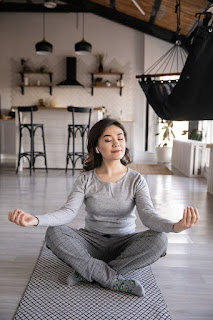
Staying Motivated Without a Class: Setting Intentions and Goals
Transitioning to a home yoga practice brings the challenge of maintaining motivation without the external accountability of a scheduled class. However, it also offers an invaluable opportunity to cultivate a deeper, more personal connection with your practice. Here’s how to nurture that motivation, drawing from within to sustain and enrich your journey.
Finding Your ‘Why’
Begin by reflecting on why you practice yoga. Is it for physical health, mental clarity, emotional balance, or perhaps a combination of these? Understanding your core motivations serves as a powerful reminder, especially on days when stepping onto the mat feels more like a chore than a choice. Your ‘why’ is your anchor, reminding you of the value yoga adds to your life.
Setting Intentions and Goals
Intentions are not about achieving a specific outcome but rather setting a direction for your practice. An intention could be as simple as being present, cultivating gratitude, or opening your heart. Unlike intentions, goals are measurable and might include mastering a particular pose, extending your practice time, or integrating meditation into your sessions. Both intentions and goals give your practice purpose and direction.
Creating a Supportive Environment
Your environment plays a significant role in maintaining motivation. Just as you’ve designed your physical space to inspire serenity and focus, consider how other environmental factors, such as the time of day you practice or the music you listen to, can create a supportive atmosphere that encourages regular practice.
Embracing Variety
A common motivation dampener is routine fatigue. Keep your practice vibrant by introducing variety. Explore different yoga styles, challenge yourself with new poses, or switch up your practice length. Online resources can be instrumental in providing new ideas and inspiration, ensuring your practice remains engaging and growth-oriented.
Community Connection
While your practice is personal, connecting with the yoga community can offer a boost of motivation. Sharing your experiences, challenges, and successes with like-minded individuals can provide encouragement, accountability, and a sense of belonging. Whether through social media, online forums, or virtual classes, being part of a community reminds you that you’re not alone on this path.
Celebrate Your Progress
Acknowledging and celebrating your progress, no matter how small, is vital. Each step forward, be it in flexibility, strength, or mental clarity, is a testament to your dedication. Reflecting on how far you’ve come can be a powerful motivator, reinforcing the value of your practice.
Listen to Your Body and Mind
Finally, remember that motivation ebbs and flows. There will be days when your practice is invigorating and days when it feels like a struggle. Listening to your body and mind, and adjusting your practice accordingly, is crucial. Some days, a gentle restorative session might be more beneficial than an intense vinyasa flow. Respecting your needs helps sustain motivation over the long term by avoiding burnout and fostering a sustainable, joyful practice.
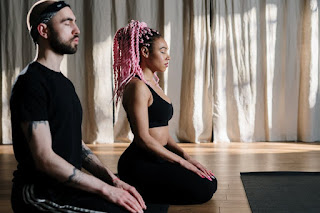
The Benefits of Solo Practice: Personal Growth and Self-Discovery
The journey of yoga is deeply personal, and practicing solo at home offers a unique pathway to self-discovery and personal growth. Without the structure of a class, you’re free to explore the depths of your practice, learning not just about the asanas but about yourself. This exploration can lead to profound insights and a deeper connection with your inner being.
Deepened Self-Awareness
Solo practice invites an introspective journey. It’s a time to listen to your body and mind, noticing how different poses affect your emotions and thoughts. This heightened awareness can extend beyond your yoga mat, influencing how you interact with the world around you. It cultivates mindfulness, helping you to live more fully in the present moment.
Freedom to Explore
Practicing yoga alone allows you the freedom to explore. You can dive into poses that challenge you, spend more time in meditative states, or explore the subtleties of your breathwork. This freedom encourages a spirit of curiosity and experimentation, vital for growth and mastery of the practice.
Cultivating Inner Strength
Solo practice develops more than just physical strength; it builds mental and emotional resilience. Facing challenges on the mat alone teaches you to navigate difficulties with grace and perseverance. This inner strength is a powerful asset, providing courage and confidence in all areas of life.
Enhanced Connection to the Practice
Yoga is more than a physical exercise; it’s a holistic system designed for spiritual and emotional well-being. Practicing alone deepens your connection to the essence of yoga, allowing you to explore its philosophical and spiritual dimensions. This can lead to a more meaningful and enriched practice that nourishes your soul.
Personalized Pace and Focus
Everyone’s body and journey with yoga are unique. Solo practice respects this individuality, allowing you to set your own pace and focus on what feels most necessary for your growth. Whether it’s mastering challenging poses, enhancing flexibility, or finding mental clarity, your home practice is tailored exclusively to your needs.
Encourages Routine and Discipline
While initially, it might seem challenging to motivate yourself, over time, solo practice fosters a sense of routine and discipline. The commitment to step onto the mat, even when you’re not inclined, is a practice in itself, teaching you about dedication, commitment, and the rewards of consistency.
The Joy of Solitude
In today’s fast-paced world, moments of solitude are precious. Your solo yoga practice offers a rare opportunity for quiet and introspection, a time to disconnect from the external and reconnect with the internal. This solitude is not about loneliness but about cherishing the peace and quiet that fosters self-healing and rejuvenation.
Conclusion
Embarking on a yoga practice within the comfort and solitude of your home opens a portal to unprecedented personal growth and self-discovery. By designing a space that resonates with tranquility and inspiration, you lay down the physical groundwork for a practice that transcends the physical realm, inviting a profound exploration of mind, body, and spirit. The journey of building a home yoga practice, enriched by the vast expanse of online resources, cultivates not only discipline and flexibility but also a deep-seated connection to one’s inner world. In this solitude, motivation becomes a reflection of personal commitment, and every session is an opportunity to celebrate progress and honor the self. Solo practice, thus, becomes not just a practice of yoga but a practice of life—fostering resilience, awareness, and a harmonious balance that radiates beyond the mat.
As you continue to unfold the layers of your practice, remember that the sanctuary you’ve created is a mirror of your inner sanctum—a sacred space for growth, healing, and the pure joy of being. May your home yoga practice be a source of endless discovery, a path to inner peace, and a testament to the strength and flexibility that resides within.
Namaste
